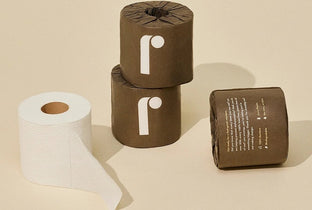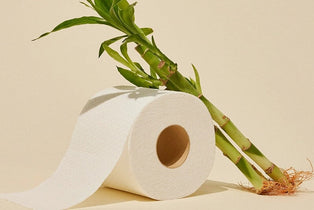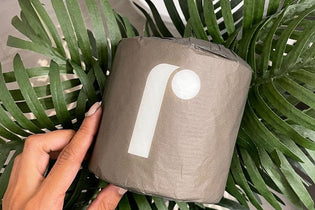
TLDR
From phthalates in your cleaning products to polyvinyl chloride in your shower curtain, your bathroom could be one of the most contaminated places in your home. Here are some tips for improving your indoor air quality.
Written by Abbie Davidson of The Filtery for Reel
According to the EPA, a growing body of research indicates that indoor air pollution is often worse than outdoor air pollution. This is in part due to a lack of airflow, but it’s also because of the sheer amount of chemicals in our homes, schools, and workplaces.
From PFAS and flame retardants in our furniture to phthalates and chlorine in our scented cleaning products, we are exposed to a lot of potentially toxic chemicals in our homes.
The bathroom may be one of the most toxic parts of the home. Not only do most people use a lot of personal care and cleaning products in the bathroom, but it’s also a small space with even less airflow than other parts of the house. Add to that the fact that moisture levels in the bathroom can be a breeding ground for toxic mold, too.
So, in this article, I’m going to give you the rundown of the most common toxicants to look out for in your bathroom… and some ways you can reduce them.
1. Mystery “Fragrances”
Because of what’s commonly referred to as the “fragrance loophole,” U.S. law allows manufacturers to include about 4,000 different chemicals in products under just one word: “fragrance” (or sometimes, “parfum”). Many of these chemicals are safe, while others are endocrine disruptors, carcinogens, and allergens.
For example, you’ve probably heard of phthalates. They’re endocrine-disrupting chemicals (EDCs) that can have serious downstream effects, including infertility, developmental problems, and cancer. Several phthalates are allowed under the “fragrance” umbrella (they’re used to make fragrances last longer). That means consumers have virtually no way of knowing whether or not their skincare products, cleaning supplies, or air fresheners have phthalates in them just by looking at the ingredient list.
One thing you can do to decrease your exposure to these mystery chemicals is simply opt for fragrance-free products. Or, if and when you do buy scented goods, look for brands that refuse to use ingredients like phthalates and are transparent about which ingredients are actually used in their fragrances.
2. Harmful Preservatives
Preservatives are obviously important in things like personal care and cosmetics because they help prevent bacteria, mold, and mildew, while also extending the shelf life of the product and preventing waste.
However, many preservatives come with problems. Parabens, for example, are endocrine disruptors that are commonly used in things like shampoos, facial cleansers, and lotions.
Formaldehyde and formaldehyde-releasing chemicals like quaternium-15 and DMDM hydantoin are also used as preservatives in things like shampoo and body wash. Formaldehyde is a known carcinogen, and it can also cause acute allergic skin reactions in some people. Many countries like Japan, Canada, and the E.U. have restrictions or bans on formaldehyde and formaldehyde-releasers in toiletries.
Butylated compounds such as butylated hydroxyanisole (BHA) and butylated hydroxytoluene (BHT) are commonly used in cosmetics and creams even though there is increasing evidence that they could have endocrine-disrupting and carcinogenic effects.
Isothiazolinone preservatives, like methylisothiazolinone (MIT) and benzisothiazolinone (BIT), are irritants that can exacerbate symptoms for those with eczema or sensitive skin. MIT was even named the 2013 Allergen of the Year by the American Contact Dermatitis Society due to the skin sensitization resulting from dermal exposure. These are also commonly used in soaps, shampoos, and cleaning products—even some of the brands that are marketed as “green.”
Look for third-party labels like MADE SAFE and EWG Verified on your skincare, cosmetics, and cleaning products. Most of these labels ban or restrict not only things like parabens and BHT, but also a wide variety of other toxic chemicals.
3. PFAS
PFAS (a.k.a. per- and polyfluorinated substances) are in the news a lot these days. It’s the family of chemicals that Teflon belongs to, but they’re not just used in non-stick cookware. These “forever chemicals” are found in food packaging, waterproof clothing like rain jackets, stain-resistant textiles like upholstered furniture, cosmetics, and more.
PFAS are used in makeup to create a smooth finish and/or to make a product waterproof and longer-lasting. It can also be found as a contaminant from the manufacturing process (which means it’s not added on purpose and therefore won’t be listed on an ingredient label).
Some research also indicates that toilet paper could be a significant source of PFAS pollution in our water supply! (Luckily, Reel’s toilet paper is regularly monitored and tested for contaminants like PFAS.)
The potential long term health effects of PFAS are sweeping. They include cancer, hormone disruption, high cholesterol, high blood pressure, thyroid dysfunction, ulcerative colitis, immune deficiencies, and more.
Avoiding “waterproof” and “long-lasting” makeup is one way to reduce PFAS, while also being on the lookout for ingredients that have “perfluoro-” in the name.
4. Certain Dyes
From cosmetics to hair dye, there are probably a lot of colorants in your bathroom as well.
Some dyes are worse than others. Many of them are derived from petroleum and/or coal tar. These chemicals can contain a variety of different toxicants, including polycyclic aromatic hydrocarbons (PAHs), a class of chemicals suspected to be carcinogenic.
Color pigments are also how many cosmetics tend to get contaminated with toxic heavy metals such as lead and cadmium.
For hair dye, you also have to worry about extra chemicals that are used to bond the colorants to your hair. For example, p-phenylenediamine is often used in permanent hair dyes even though it’s linked to skin sensitization, DNA mutation, certain cancers, and organ toxicity.
Resorcinol is another common hair dye ingredient that’s used to make the color stay on your hair, but is linked to endocrine disruption, organ system toxicity, and skin irritation.
Embracing your gray hair or using a safer color-restoring product like Hairprint is one way to reduce your exposure to these kinds of toxic dye chemicals.
4. Carcinogenic Contaminants
Sometimes, toxic chemicals aren’t added to consumer goods on purpose, but make their way into products via contamination.
We already mentioned heavy metal contamination in dyes as well as PFAS in makeup due to the manufacturing process.
Asbestos is another example of carcinogenic contamination. This carcinogen is commonly found as a contaminant in talc products, which includes things like baby powder and powdered makeup. Look for brands that are either talc-free or can certify that their talc products are free from asbestos.
1,4 dioxane and ethylene oxide are two more carcinogens that tend to contaminate ethoxylated ingredients such as “PEGs” and “laureths.” This category of ingredients is extremely common in personal care and cleaning products; it’s almost impossible to avoid them completely! 1,4 dioxane and ethylene oxide are used in the manufacturing process and can be leftover in the final product. Again, since they’re not actually added intentionally, they won’t be listed on the ingredient label. Some non-toxic personal care brands either don’t use ethoxylated ingredients at all (or very minimally), or they actually vacuum strip the ethoxylated ingredients used in their products in order to eliminate potential contamination.
Benzene is another carcinogenic contaminant that’s been found in aerosol sprays like deodorant, sunscreen, and dry shampoo. Simply skipping aerosol sprays and opting for pump sprays, lotions, and powders instead can help you avoid this contaminant.
Dioxins and furans are also toxic byproducts that often result from chlorine manufacturing. According to the World Health Organization (WHO), dioxins “can cause reproductive and developmental problems, damage the immune system, interfere with hormones and also cause cancer.” (This is why Reel uses the elemental chlorine free—or ECF—method, which is a safer bleaching technique that does not produce dioxin byproducts.)
5. PVC
Another place to look out for toxins in your bathroom is your shower curtain! Many plastic shower curtains and liners are made from PVC, one of the most toxic kinds of plastic. PVC can release all kinds of chemicals, including dioxins, phthalates, lead, polyvinyl chloride (the main toxicant that was released during the East Palestine train disaster), and more. Hot showers can make things even worse, since leaching tends to increase with heat.
Switching to a shower curtain made from natural (and machine-washable!) fabrics like organic cotton, hemp, or linen, can be an easy way to minimize PVC in your bathroom.
6. Textile Chemicals
Speaking of shower curtains, think about the other textiles in your bathroom, like bath towels and bath mats. Although most textile tags will tell you what the main fabric is made out of (like cotton or polyester, for example), it won’t tell you what chemicals were used to process that fiber, nor what’s added to the final product.
There’s a wide range of harsh chemicals that may be added to textiles: azo dyes are used to make fabrics brightly colored; formaldehyde is used to prevent shrinking and as a fungicide during shipping; antimony (a heavy metal) is often used in polyester production; and more.
Looking for organic cotton towels and bath mats that use non-toxic dyes (or no dyes) and are not treated with extra chemicals is one way to avoid this problem. Luckily, it’s much easier to find organic and non-toxic textiles these days! Looking for third-party labels like OEKO-TEX and GOTS Organic can help.
7. Tap Water Contaminants
In the United States, we are privileged enough that our tap water is generally free from pathogens that can make us acutely ill. However, that doesn’t mean our water is totally “clean” either. In fact, there are a lot of different kinds of contaminants in tap water, including PFAS, lead, industrial chemicals, disinfection byproducts, and more. Researchers have actually studied the impact that bathing can have on indoor air pollution due to the volatilization of chemicals in your home.
Although shower head filters can’t get rid of all of these chemicals, they can definitely help reduce your exposure. (Or a whole-house filter is even better, if you own your home and can make the investment!)
8. Mold
Even though mold is a normal part of our ecosystems, certain varieties can become toxic, especially to those that are more sensitive to it. Because of the general humidity and moisture levels in the bathroom, it can be a prime spot for mold growth. It’s not always visible, either!
Running the fan, opening doors/windows, running a dehumidifier, and doing whatever you can to keep air flowing in the bathroom is good practice. It generally takes 24 to 48 hours for mold to start growing, so try to let the bathroom fully air out in between showers.
Other tips include:
- Keep cracks filled with caulk
- Regularly wash and dry loofahs, washcloths, towels, shower curtains, and bath mats
- Use a daily shower cleaner and/or squeegee
- Do regular checks for leaks under the sink
- Keep your eye out for puddles, discoloration on the walls, or other signs of potential mold
Admittedly, learning about all of the potential contaminants in your bathroom can be overwhelming, especially if you’re just starting the journey toward a less toxic and more eco-conscious lifestyle.
Minimizing personal care and cleaning products can be a great place to start because they’re relatively low cost, you use them all the time, and they’re usually right against your skin. The important thing is just to take it one step at a time!
About the Author
Abbie Davidson is the Editor of The Filtery, a digital platform that provides curious citizens with well-researched and practical solutions for decreasing the toxins in their bodies and homes.




0 comments